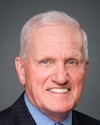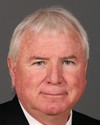The LAV III, of course, is an eight-wheeled armoured personnel carrier, and for the threat in Afghanistan it's well armoured. The Taliban have fired a number of their small rockets at the LAVs to no effect. Once in a while some of our people get injured because they happen to be out of the turret and a piece of shrapnel hits them or something like that. Recently the Taliban fired four rounds at one of these LAVs to no effect. From an armour protection point of view and for the threat they're in, they're quite good.
They also have dealt quite well with mines, because the Taliban put these mines in the road. They're able to take a hit of multiple mines and basically our soldiers survive inside them. They may be shaken up, because the thing gets lifted, but usually wheels get blown off and things like that.
Recently the Taliban blew up a mine or mines around one of our LAVs and we had to abandon it because it caught on fire. There was fuel or ammo around and it caught on fire, so we destroyed it. The Taliban themselves didn't destroy it; it was a consequence of a fire.
With respect to the Nyala, the Nyala is a vehicle that was developed in South Africa. I'm trying to remember, but I think it has four wheels. It's very high off the ground and the bottom of it is wedged--armour plate in a wedge--so that when you have an explosion, it diffuses the force. It's built so that if it goes under an explosion, the wheels, the engine, etc. blow off. I've seen a picture of a Nyala after it went under a very heavy mine blast and the soldiers inside survived with minor injuries. The main vessel itself was untouched, but the wheels and the engine were blown off. They are quite effective against mines. They're also effective against small arms and things like that.
The G-Wagon in simple terms is a Mercedes jeep. It's a very good vehicle too for moving people around. They have limited armour protection. My understanding--and if I'm wrong here, Admiral, you tell me--is that in future we're going to limit nearly all the G-wagons to inside the camp to move supplies around and things like that. There may be an exception here and there of putting a few G-wagons out beyond the camp, but essentially our ground forces will be moving in either Nyalas or LAVs when they go out on missions because for the threat they're dealing with, they're pretty effective. You can't protect against everything. You can make an explosive big enough to move a tank, but right now these vehicles are very good for the forces.




